Analysis of recent works
Emily Patrick is a painter resolutely indifferent to passing artistic trends. Her respect for the art of the past and her place among its heirs is manifest in her choice of subjects: the time-honoured genres of portraiture and domestic scenes, landscape and still-life. It is also evident in the paramount importance she attaches to nature, and in her commitment to self-improvement through a repeated and arduous process of looking, a process which is at the heart of the figurative tradition, bringing to mind the rigorously self-critical approach of Degas. Moreoever, like many past masters of this tradition - Degas, Fantin Latour or Chardin for instance, with each of whom her art has affinities, although she would blush at the comparison - Patrick returns repeatedly to the same subjects (even, frequently, to the same objects: a particular lustreware teacup, the magnolia tree in her garden, or indeed her own features).
Moreover, like countless artists concerned with the representation of nature from the Van Eycks onwards, Patrick does not simply reproduce the visual world, but manipulates it, taking a delight in the abstract qualities of line, form and colour, and challenging the viewer's perceptions. Even her most apparently artless works are carefully contrived, such as Two Pears on Twig. At first sight no more than a painted snapshot, this work is in fact as rigorously controlled in design as a Japanese painting. Its profoundly satisfying quality lies not merely in Patrick's skill in recording this particular fragment of nature, but in how she chooses to present it: in the interplay of knobbly branches and the rounded forms of the fruit, the varying focus of the leaves, the restricted palette, the relationship between coloured subject and neutral background. It lies in the textures of the paint itself, which encompass an astonishing range for such a tiny painting, from creamily bold to delicately detailed, from thin and fluid to dry and spare. It lies, too, in the skill with which, within a very limited frame of vision, she suggests movement and depth. Yet are the faint brownish dapples in the background to be read as dancing shadows cast on a wall, or simply as a pattern on the picture surface? With characteristically gentle wit Patrick reminds us that we are looking not at three-dimensional reality but at a two-dimensional image; the artist's presence is further underscored by faintest preparatory pencil lines deliberately left un-erased.
Patrick's sensitivity to nature is generally explained by her upbringing in rural Kent. Her relationship with nature is, however, more complex than this would suggest. She grew up in the garden of England - but on a farm devoted to intensive poultry rearing, surrounded, as she vividly describes it, by chicken-wire, chicken-shit and mud. This was no rural idyll, but a daily engagement with the harsh and often ugly realities of country life. The Patrick children were expected to pull their weight on the farm: at an age when most children are playing with cuddly toys, Emily was catching hens, crawling beneath the slatted floors of vast barns on a metre-thick bed of chicken slurry, the air thick with dust and the smell of ammonia, her hands blistered by the scaly legs of the birds. Her unromantic approach to nature is undoubtedly the legacy of this childhood. Yet life on the farm also developed her gift for patient observation: another of her duties involved ensuring that the feeding mechanism did not become blocked, and hours spent meditatively watching the flow of fine particles of chicken-feed were, she feels, helpful in producing an understanding of the natural flow of line.
Despite these unprepossessing surroundings, Patrick was from an early age sensitive to the beauty of nature, and, significantly, to the act of painting it. The farm was situated in a beautiful valley - subliminally, its woods and wildflowers offered an alternative vision of nature. It also provided a refuge. A favourite retreat was in the boughs of a tree on the slope overlooking the farm (too far away for Emily to be noticed and chivvied, but near enough for her to know what was happening); she spent a lot of time, she says, looking at tree trunks, which became almost like friends - a kinship which still resonates in her paintings. Patrick also recalls spending days during one haymaking season, when she was five, watching the artist Jehan Daly painting the valley, fascinated by the tenderness with which he viewed it, and the unhurriedness with which he worked.
If nature is one leitmotif of Patrick's work, art is another. Again, the roots of this lie in her childhood, in visits to her grandmothers, and in her father's influence. Her paternal grandmother was a talented amateur painter, and as a child Emily loved watching her, entranced by her materials and equipment: together they would get out her brushes, and then came the deliciousness of seeing the paint being squeezed from tubes. At the age of eleven she was given her own oil paints, and began painting in earnest. There was a constant supply of wooden boards available for her to paint on, furnished by her father's antiques business, which - unlikely as it may seem, amidst the mud and slurry - was run from one of the barns. To this day, board, rather than canvas, remains Patrick's preferred choice of support. Her father, a formidable character with a strong aesthetic sense, also provided an emotional spur for her art: praise from him was praise indeed, but equally, his criticism could be crushing.
It was, though, at her maternal grandmother's house that she received her first lessons in prizing artistic quality. Her grandmother owned two early oil paintings by the Irish painter Jack Yeats (1871-1957), one of which, Returning from the races, made a particular impression on Emily. A tiny work executed with vigorous brushstrokes, it depicts two figures - a jockey on horseback and a man walking behind - leaving a small race meeting in the west of Ireland, along a muddy road. Its air of physical exhaustion and its muddy setting struck a chord in the child, who was familiar with both. Yet what also struck her, was the fact that mud and exhaustion could be presented in such a way as to be beautiful. Her grandmother also owned netsuke and fine Japanese laquer-work, which Emily would handle, savouring their exquisite quality. Far removed from life on the farm, these beautiful paintings and objects opened the door to a dazzling other world. Their legacy can be seen in Patrick's ability to transform the most mundane subjects (a pair of shoes, a head of garlic) into the beautiful, in her love-affair with paint (the rich creaminess of Yeats's brushwork made a lasting impression), and in the immensely tactile quality of her still lifes: like the child Emily handling her grandmother's netsuke, we yearn to 'handle' the delicate china she paints.
Patrick's first encounter with the wider world of art came at the age of fifteen, on a visit to Bruges, Amsterdam and the Hague, where the museums were a revelation. With a long-suffering schoolfriend, she spent hours looking at paintings. Two particular works stood out in this formative first encounter: a Portrait of a Lady ('The Persian Sybil') by Memling (c. 1475, Bruges, St John's Hospital), and The Young Bull by Paulus Potter (1647, The Hague, Mauritshuis). Both, significantly, depict subjects which Patrick has since made her own and which evidently had an innate attraction for her. The appeal of the Paulus Potter for the farmer's daughter is readily understood, yet it was not only the subject - a herdsman leaning against a tree behind a group of sheep and cattle - which attracted her, but its authentic treatment: she recognised in it the hand of a countryman thoroughly at home with beasts, bark and, indeed, mud. Twenty-five years on, her affinity with this painting is underscored by the striking (if unintentional) kinship between the tree trunks and leaves silhouetted against Potter's sky, and Patrick's own Pears on Twig.
By contrast, the appeal of the Memling, a small, bust-length portrait, with its smooth brushwork and static pose, may seem less obvious. However, for the young Patrick, the black, white and red of the costume recalled the colours of her grandmother's Japanese laquerwork. Moreover, the portrait's strong sense of geometric design combined with its delicate mood and the gentle, self-effacing character of the sitter, reach to the heart of Patrick's own artistic creed.
A cherished postcard of the Memling, a souvenir of that visit to Bruges, is the centrepiece in Postcards become Abstract, together with a favourite teacup, with which it engages in a typically Patrick-esque counterpoint of colours and forms: bold versus delicate, flat versus round. Much more allusively, the Memling is recalled in Self with Asymmetric Collar, in the bold V-shape and the juxtaposed blackish-brown and white of the shirt front. Admittedly, the analogy goes no further. Memling, an early exponent of oil painting, would never have dreamed of doing with the medium what Patrick does here. Whereas Memling achieves a perfectly smooth finish using almost imperceptible brushstrokes, Patrick delights in the physical properties of the paint. In Memling clothes and jewellery are given the same detailed attention as the face, but Patrick varies the focus, differentiating between the incidental and the essential through the application of paint. The sense of casual, rumpled garments is conveyed by applying thickly impasted strokes alongside passages where the paint is barely there at all, having been wiped away to reveal the ground beneath. The most considered, richly-applied paint is reserved for the face. In contrast to the riot of loose brushstrokes which indicate the clothes, the contours and volumes of the features are built up through dense strata of superimposed pinks and browns with a laden brush.
Patrick delights in the visual impact of diverse brushwork. The closest she came to it on this first encounter with the old masters was in the work of Rembrandt. Significantly, it was a self-portrait, in the Rijksmuseum, which most struck her. Again there is an innate kinship here: Patrick brings to the depiction of her own features the same penetrating honesty, utterly lacking in pretension.
Her artistic education continued, with a visit to Paris the following year, when she fell under the spell of Fantin Latour and Manet. A pattern emerges of Patrick's tastes and art-historical interests which is in complete harmony with her own art, and enriches our appreciation of it. Interestingly, it is the more objective and naturalistic art of northern Europe towards which she is repeatedly drawn. Not for her the grand manner of Italy, where she travelled next (her favourite Italian painter, Carpaccio, is one of the most unassuming). With great consistency Patrick singles out for her personal Pantheon, painters from different periods and schools with whom she shares common ground: painters of flower pieces (Jan 'Velvet' Bruegel and Fantin Latour); painters of distilled form and luscious brushwork (Manet, Degas and the early twentieth-century British artist William Nicholson); master portraitists (Degas again, and Holbein, whose ravishing, near-abstract Portrait of a Lady in the Mauritshuis, seen on her first artistic pilgrimage, makes another fascinating comparison with Self with Asymmetric Collar); landscape painters (notably the unknown ancient Roman painter of the frescoes in the House of Livia, whose exuberant view of nature and strong sense of form are akin to her own).
Although she had been painting since childhood, Patrick never studied art or art history formally, bar a handful of drawing lessons with John Doyle and in the studio of John Ward. She read architecture at Cambridge (1979-82), which played a strong part in developing her feeling for structure and space. The legacy of this training (even the uncongenial, for her, discipline of architectural drawing) is discernible in the spatially complex Long Horizontal Self, with its rhythmic deployment of horizontals and verticals, and particularly in the superbly rendered doorway-vista, window and blind. Painted using three mirrors, this work explores different light sources and their effects (again she is in good company - one thinks of Velasquez and Vermeer): the bright light spilling onto the window embrasure, diffuse light seen through the doorway, the shadows through the further door, light filtered through transparent objects - a thin blind, a glass bottle - or reflected off the polished surfaces of china and metal.
After Cambridge (where she began selling paintings to supplement her grant), Patrick embarked on a career as a portrait painter, for which she found she had an aptitude. Again, it was the old masters who were her teachers: she learnt by copying portraits by Frans Hals, Nattier and Gainsborough in the National Gallery (just as her heroes, Manet and Degas had taught themselves by studying old masters in the Louvre). Portrait painting proved increasingly demanding, however, especially after the birth of her first child, and at this point Patrick ceased taking portrait commissions, finding it more congenial (and simpler) to paint herself and her babies. Family has become intrinsic to her art, whether as subject-matter (that first baby is now the teenager revising in a deckchair in Girl's Knees), or in a collaborative role (her husband Michael Perry makes and gilds her frames and designs her exhibitions).
Increasingly, however, Patrick chose to concentrate on still-life, an art form in which she had already made a mark in her first, sell-out exhibition, at Agnew's in 1986, and which has become her metier. Still-life enables Patrick to engage with those aspects of representation which most attract her, and for which she possesses such an affinity: the abstract values of line and form, and the potential of paint to enhance structure as well as to describe light and texture. Brown Ribbon with White Jug exemplifies these dual concerns. As in a flower-piece by Jan Bruegel, the jug with its delicate painted spray of flowers is the focus of the composition, its roundness subtly reiterated in the slender curves of the stems, contrasted with - and anchored by - the verticals of the easel and the straight white edges of the postcards.
As the eye moves outwards, the postcards become increasingly approximate, treated as blocks of neutral colour, until representation gives way completely to abstraction, and they are simply implicit in the diagonal strokes of white paint. Characteristic of Patrick, too, is the restrained use of delicate colour, which is also employed to compositional effect: pink, mauve and green concentrated in the centre, neutral white, grey and brown predominant at the edges. The brown ribbon around the neck of the jug (like the ribbon around the pale neck of Manet's Olympia) pulls the whole together. The painting has depths as well as surface beauties: literally, in the dark shadows behind the easel, and metaphorically, with its evocations of youth and age, of unknowable personal histories, of transience, suggested by the faces on the postcards and the short-lived wild flowers.
Cadmium Maple Leaves presents familiar material - leaves in a jug (straight-sided, this time, complementing the angular forms of the leaves) - but is executed in what is for Patrick a new technique, egg tempera. Learnt in part from D.V. Thompson's classic Materials and Techniques of Medieval Painting, this is additional testimony to her respect for the past.
Patrick's tempera is, however, no more like that of the medieval masters - who applied it in minute brushstrokes producing an enamel-like surface - than her oil painting is like Memling's. Because tempera has a lower light-refractive index than oil, the tonal range is narrower and colours are less saturated than in oil painting. She exploits the medium (egg yolk thinned with a little water) for its luminous, translucent qualities, applying it in thin streaks of limpid colour, through which the preparatory underlayer of the white gesso ground shines, enhancing the visual effect. The result is extraordinarily light, almost irridescent. This lightness is subtly and wittily extended by Patrick to the forms themselves. The jug appears to float amongst streaks of white and blue; it is barely differentiated from the background, which logic tells us is an interior, yet which can also be construed as a cloud-streaked sky, against which the vibrant red leaves dance as if still on the tree. Patrick's manifest delight in the cadmium red reflects what is for her one of the principal joys of this new medium - the use of pure pigment, a prerequiste in egg tempera, which cannot be bought ready-mixed in tubes. Small pigment jars full of finely-ground brilliant colour have also found their way into Patrick's formal repertoire, as in Pomegranate and Wallpaper, joining the familiar paperbacks, fruit and teacups as still-life elements lovely in their own right.
Tempera, though, can never match oil for that lusciousness of handling which is so fundamental for Patrick. In some works she has experimented, allowing the egg to dry so that it can be applied impasto ('scrambled egg', as she puts it), for instance in Alentejo (Worked Earth). Elsewhere, as in Wild Peonies, she adds finishing touches of oil to achieve the desired textural richness.
Within the self-imposed narrow remit of her subject-matter, Patrick achieves a remarkable range, as is evident from comparison of Flowering Magnolia and Two Cups and Hyacinth, both also painted in tempera. The first is large, an outdoor scene, its subject determined by nature, the other is small, set in an interior, its components chosen by the artist. One describes an entirely natural subject, the other juxtaposes the natural with the man-made. Flowering Magnolia is exuberant, free and full of movement, the Two Cups structured, controlled and still. Both display Patrick's superb sense of form, line and colour, although to very different effect.
In Flowering Magnolia the deceptively two-dimensional surface pattern of pink blossoms and dark boughs belies a deep three-dimensional space, which is revealed almost teasingly, through manipulations of scale, line and brushwork. At centre right the largest and most elaborately painted flowers float towards us; to the left the tree-trunk twists inwards and away; beyond, forms dissolve into a creamy blur, where the paint has been wiped away with a damp cloth, allowing the white ground to show. This is Patrick revelling in what paint can do - petals become delectable swirls of lucent pink and white paint, ranging from eggshell-opaque to gauzily transparent, like the layers of a chiffon corsage. The brushwork acquires a life of its own, beyond the service of mere representation: paint for paint's sake.
In Flowering Magnolia, space implicitly continues beyond the frame (itself coloured carefully, like all Patrick's frames, to complement the painting). By contrast, the Two Cups are seen in close-up; we are drawn into their tranquil, gleaming presence and invited to focus on them alone; whatever space or time exists beyond the objects and the moment is carefully excluded.
Our focus is on the abstract symmetery of the round forms, the handles arranged to describe a diagonal, and on the interplay of stems and leaves - their curved and straight lines, open and closed pairings. Our eye pauses and delights in the smallest details - the creamy highlight inside a cup, a lovingly touched-in petal. It savours the textures of the paint, and registers the subtle harmonies of Patrick's colour - the variety of whites, the blue spots on the teacups which echo the flecked petals of the hyacinth, the touches of pink and blue in the tablecloth picking up the colours of the flowers.
Perhaps this is the ultimate joy of Patrick's paintings: that they continually invite our gaze and reward it. We never tire of looking at them, and each revisiting yields fresh pleasures and insights. Her paintings do not rely on sensation or novelty-value for effect, but on the same enduring qualities that have ensured that the old masters whom she so admires have stood the test of time.
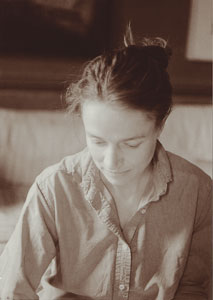 Emily Painting
Emily Painting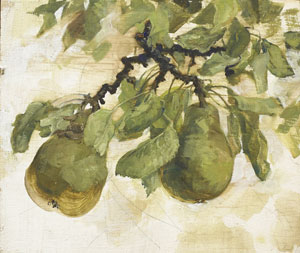 Two Pears on Twig II, 2004
Two Pears on Twig II, 2004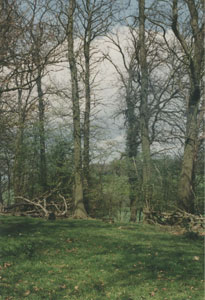 Ladwood Trees, photograph
Ladwood Trees, photograph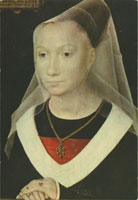 Memling, Persian Sybil
Memling, Persian Sybil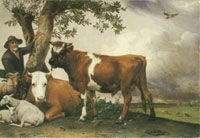 Potter, The Young Bull
Potter, The Young Bull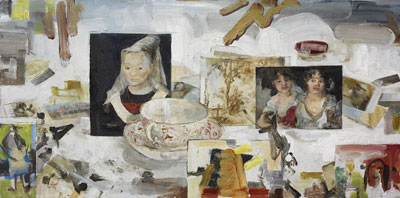 Postcards become Abstract, 2002
Postcards become Abstract, 2002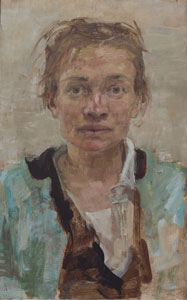 Self with Assymetric Collar, 2004
Self with Assymetric Collar, 2004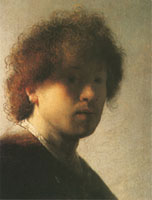 Rembrandt, Young self
Rembrandt, Young self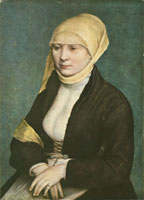 Holbein, Unknown Lady
Holbein, Unknown Lady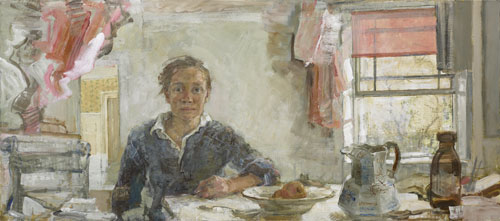 Long Horizontal Self, 2002
Long Horizontal Self, 2002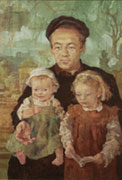 Family, 1991
Family, 1991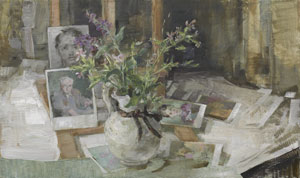 Brown Ribbon with White Jug, 2003
Brown Ribbon with White Jug, 2003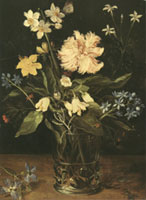 Bruegel, Flower piece
Bruegel, Flower piece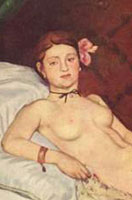 Manet, Olympia
Manet, Olympia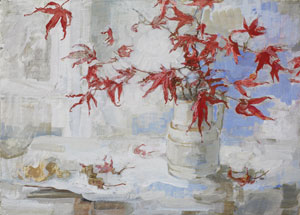 Cadmium Maple Leaves, 2003
Cadmium Maple Leaves, 2003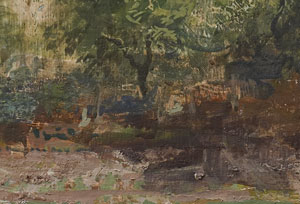 detail of Alentejo (Worked Earth), 2004
detail of Alentejo (Worked Earth), 2004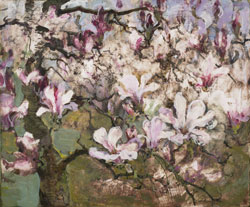 Flowering Magnolia, 2004
Flowering Magnolia, 2004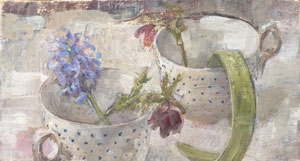 Two Cups and Hyacinth, 2003
Two Cups and Hyacinth, 2003